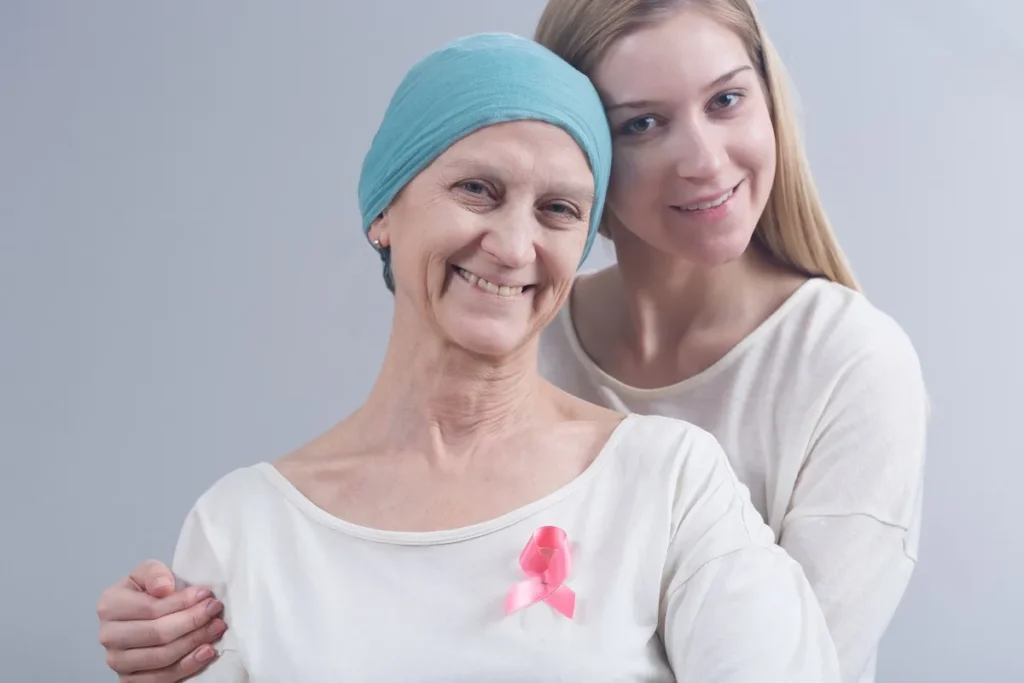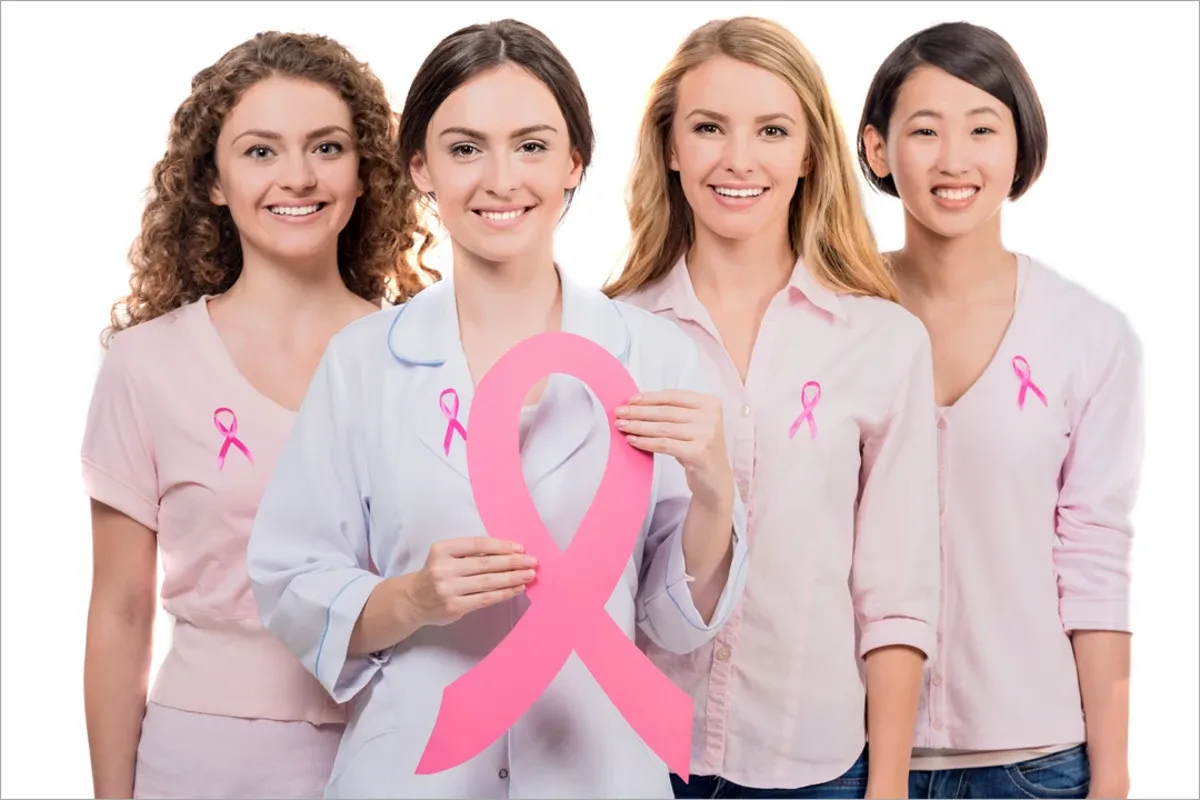Overview
What is triple-negative breast cancer (TNBC)?
Triple-negative breast cancer TNBC is a rare form of invasive breast cancer. It accounts for 15% of all invasive breast cancer cases. Unlike most breast cancers, triple-negative breast cancer cells don’t have the following characteristics:
- Receptors for estrogen and progesterone. About two-thirds of breast cancers have receptors for estrogen and progesterone hormones. Receptors are molecules on cells’ surfaces that determine what substances can attach to cells and affect what the cells do. Triple-negative breast cancer cells don’t have these receptors.
- HER2 receptors. HER2-positive breast cancer cells account for 15% to 20% of breast cancers. HER2-positive breast cancers rely on the HER2 pathway to divide and grow rapidly. This gene makes the HER2 protein, which are also receptors. Triple-negative breast cancer cells don’t have HER2 receptors.

Symptoms and Causes (TNBC)
What are symptoms of triple-negative breast cancer (TNBC)?
Triple-negative breast cancer symptoms are the same as other more common breast cancers. TNBC symptoms may include:
- A new lump or mass.
- Swelling in all or part of a breast.
- Dimpled skin.
- Breast or nipple pain.
- Nipple retraction, when your nipple turns inward.
- Breast or Nipple skin that’s dry, flaking, thickened or red.
- Nipple discharge that’s not breast milk.
- Swollen lymph nodes. This symptom happens when breast cancer spreads to the lymph nodes under your arm or near your collarbone.
Meanwhile, as you think about your condition, consider this: many symptoms of breast cancer are similar to other conditions that are much less serious. For that reason, when you have some of the symptoms, it doesn’t directly point one to your having breast cancer. On the other hand, be doing acknowledge that similar symptoms can be caused by different causes. More importantly, this situation creates confusion. Regardless, seek professional help to ensure the right diagnosis. Ultimately, an appropriate diagnosis will be made with the cause of your symptoms.
What causes triple-negative breast cancer (TNBC)?
Researchers don’t know the exact cause, but they do link it to mutations in the BRCA genes.
What are risk factors for triple-negative breast cancer?
Triple-negative breast cancer is more likely to affect:
- Women and people assigned female at birth (AFAB) age 40 and younger.
- People with BRCA mutations. These are inherited genetic mutations that increase cancer risk.
- People who are Black or Hispanic.
Diagnosis and Tests (TNBC)
How is triple-negative breast cancer (TNBC) diagnosed?
First, a mammogram test might be carried out if there is a suspicious mass or lump in your breast. Then, they can go ahead to carry out a biopsy to obtain breast tissue. Afterwards, medical pathologists will then identify the subtype by viewing the cells through the microscope. Meanwhile, the information the biopsy results will show includes other details. Consequently, a diagnosis can be made. Besides, treatment options may be listed. To sum up, a treatment plan can be defined.
Sometimes, providers use the following tests before treatment to determine tumor size and whether it has spread:
- Magnetic resonance imaging (MRI).
- Ultrasound.
- Computed tomography (CT) scan.
- Positron emission tomography (PET) scan.
How quickly does triple-negative breast cancer (TNBC) spread?
It spreads faster than other types of breast cancer. A 2016 study evaluated the daily growth rate of breast cancer tumors from diagnosis to surgery. With this in mind, it was concluded that triple-negative breast cancer tumors increased by 1% every day. In contrast, HER2-positive breast cancer tumors increased by 0.859% daily. Based on these findings, there was quite a noticeably huge difference in growth rates, which implies a marked aggressiveness difference of the tumors. Thus, triple-negative breast cancer tumors were much more aggressive and grew at a far higher rate. This finding has important implications for treatment strategies. Tumor growth rates are critical in the effective management of breast cancer.
What are the stages of triple-negative breast cancer (TNBC)?
Healthcare providers use the TNM cancer staging system to plan treatment. (T stands for tumor size, N stands for cancer in lymph nodes and M stands for metastasis, or if the cancer has spread.) Breast cancer stages are:
- Stage 0: The disease is noninvasive. This means it hasn’t broken out of your breast ducts.
- Stage I: The cancer cells have spread to the nearby breast tissue.
- Stage II: The tumor is either smaller than 2 centimeters across and has spread to underarm lymph nodes or larger than 5 centimeters across but hasn’t spread to underarm lymph nodes. Tumors at this stage can measure anywhere between 2 to 5 centimeters across and may or may not affect nearby lymph nodes.
- Stage III: At this stage, the cancer has spread beyond the point of origin. It may have invaded nearby tissue and lymph nodes, but it hasn’t spread to distant organs. Healthcare providers may use the term “locally advanced breast cancer” to describe Stage III cancer.
- Stage IV: The cancer has spread to areas away from your breast, such as your bones, liver, lungs or brain. Stage IV breast cancer is also called metastatic breast cancer.
Management and Treatment
What is the treatment for triple-negative breast cancer?
Healthcare providers and medical researchers continue to investigate new ways to treat TNBC. Recent clinical trials are testing new combinations of drugs and new approaches to existing treatments. Some existing treatments include:
- Chemotherapy: Providers might combine chemotherapy and surgery to treat early-stage triple-negative breast cancer.
- Immunotherapy: Providers may combine immunotherapy and chemotherapy to shrink tumors before surgery. You might also receive immunotherapy for about a year after your surgery and post-surgery radiation therapy.
- Surgery: This could be a lumpectomy to remove an individual lump, or a mastectomy to remove an entire breast. Providers then perform a sentinel node biopsy, or axillary node surgery, to look for signs your breast cancer has spread to your lymph nodes.
- Targeted therapy: Providers may combine chemotherapy and immunotherapy with treatments that target cancerous cells. For example, providers may use the targeted therapy PARP inhibitors. PARP stands for poly ADP ribose polymerase, an enzyme in cells that repairs DNA damage.
- Radiation therapy: Post-surgery radiation therapy helps reduce the chance cancer will recur (come back).
What are these treatments’ side effects?
Meanwhile, each treatment has different side effects. As a result, reactions to the effects of the side effects will be different from one person to another. It is also necessary to consult your doctor about the side effects caused by a certain treatment. Moreover, they will explain their mechanisms to reduce the effects and give you a rundown of what to do to help yourself. Likewise, going out openly with your doctor will make it easy to manage side effects. In the end, you will get through treatment difficulties if there is cooperation.
Prevention
Can triple-negative breast cancer be prevented?
Researchers don’t know what causes triple-negative breast cancer, but they do link this condition to mutations or changes in the BRCA genes. However, there are steps that help prevent breast cancers, including TNBC:
- Reach and maintain a weight that’s healthy for you.
- Exercise on a regular basis.
- Know your family medical history.
- Monitor your breast health.
- Talk to your healthcare provider about genetic testing for the BRCA genes if you have a family history of breast, ovarian, pancreatic or prostate cancer.
Outlook / Prognosis
What is the prognosis or expected outcome for triple-negative breast cancer?
The prognosis for TNBC continues to improve, thanks to recent progress in identifying new treatments like immunotherapy and PARP inhibitors. Medical researchers are finding new ways to use existing treatments. Like most cancers, the earlier healthcare providers diagnose triple-negative breast cancer, the better the prognosis.
Is there a cure for triple-negative breast cancer?
Not right now, but there are treatments to help people to live longer with the condition, including cancer that comes back after treatment or has spread. For example, the U.S. Food and Drug Administration (FDA) recently approved a new type of treatment for metastatic TNBC. Antibody-drug conjugates help cancer treatments hone in on tumors by targeting cancer-specific antibodies.
What are survival rates for triple-negative breast cancer?
According to the American Cancer Society, survival rates vary depending on cancer stage at diagnosis:
- Local or Stage 0–Stage 1 survival rate: More than 90% of people were alive five years after diagnosis.
- Regional or Stage II–Stage III survival rate: More than 60% of people were alive five years after diagnosis.
- Distant or Stage IV survival rate: More than 10% of people were alive five years after diagnosis.
Meanwhile, survival rates are based only on the experience of others. As such, they often do not reflect the most recent statistics or the effectiveness of more recent treatments. Personal expectations are also important to discuss with your doctor. For one thing, they have access to the very latest information and are, therefore, your best source. Your doctor will also be able to temper their general understanding with your particular case. This will finally lead to open communication with your health provider and thus your ability to make informed decisions.
Living With
I have triple-negative breast cancer. What can I do to help myself?
Taking care of yourself is one of the most important things you can do to help yourself. Many times, cancer makes people feel as if they’ve lost control of their lives. Committing to self-care is one way to overcome that feeling. Here are some things you can do during and after your treatment:
- Triple-negative breast cancer is a rare and often misunderstood illness. Many people don’t realize this cancer can’t be treated the same as other breast cancers. As a result, you might feel isolated and alone with your cancer. If that happens, your healthcare provider can direct you to TNBC support groups and programs where you can talk to people who understand your experience.
- You’ll probably need or want help while you’re going through treatment. Your friends and family likely are eager to do what they can. Let them know how they can help you.
If you’ll need cancer surgery, ask your healthcare provider what to expect immediately after surgery and any follow-up treatment. Knowing what to expect will help you focus on what you can control rather than what you can’t control. - Cancer is stressful. You might find activities such as meditation, relaxation exercises or deep breathing exercises help to ease your stress.
- Chemotherapy treatments might affect your appetite. Try to eat a healthy diet and talk to a nutritionist if you’re having trouble eating.
- Radiation treatment can leave you feeling exhausted. Plan to rest as much as possible during your treatment.
When should I see my healthcare provider?
It’s important that you have regular follow-up care with your healthcare providers. They’ll probably want to do physical examinations every three to six months for the first three years after treatment. They might reduce your visits to every six months in the fourth and fifth years after treatment.
When should I go to the emergency room?
You might also have unusually strong side effects from your cancer treatment. While your healthcare provider likely gave you medication to help control your side effects, you should go to the emergency room if your side effects continue despite medication.
Many cancer treatments affect your immune system, increasing the chance you’ll develop infections. Symptoms that might require an emergency room visit during treatment are:
- Fever of 100.5 degrees Fahrenheit/38.05 degrees Celsius and above.
- Chills.
- Productive or “wet” cough.
- Stomach pain.
- Persistent diarrhea.
- Persistent nausea and vomiting.

What questions should I ask my doctor?
You’ll probably have many questions about your diagnosis. Here are some basic questions you might ask:
- What is triple-negative breast cancer?
- What’s the cancer stage?
- Has it spread, and if so, how far has it spread?
- What treatments do you recommend?
- Why do you recommend those treatments?
- What are those treatment side effects?
- Will I need surgery? If so, what surgery do you recommend, and why?
- Do I need genetic testing?
- What’s my prognosis or expected outcome?
- I’m interested in participating in clinical trials. Are you able to help me find one?
A note from Cleveland Clinic
Triple-negative breast cancer (TNBC) is one of the more challenging breast cancers to treat. You might be discouraged by what you’ve read about the condition. But there are several very effective treatments for TNBC, including immunotherapy, chemotherapy, surgery and radiation. And every day, researchers learn more about this rare cancer. Their knowledge is your power. If you’re concerned you aren’t getting the straight story about your cancer, ask your healthcare provider to walk you through your diagnosis and treatment options.


1 thought on “Triple-Negative Breast Cancer (TNBC)”